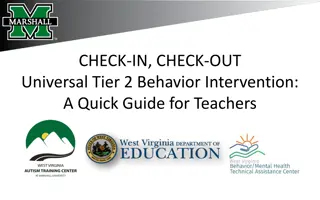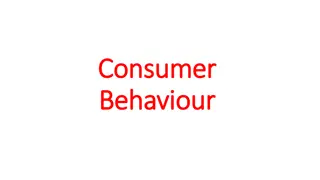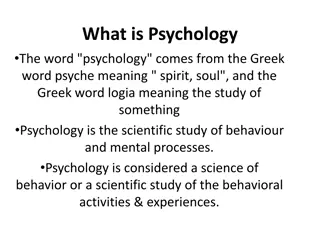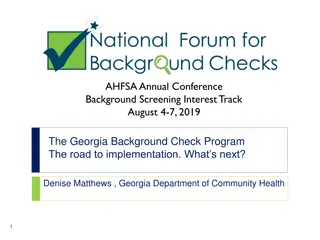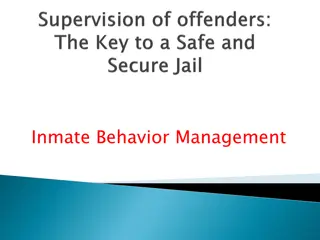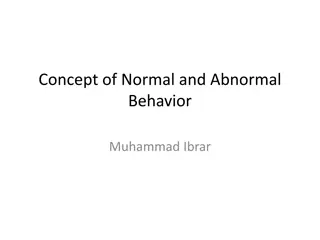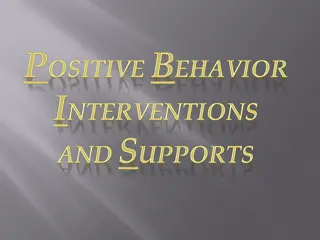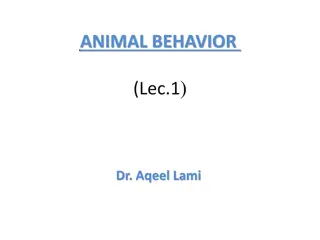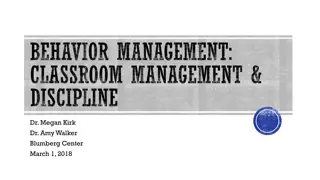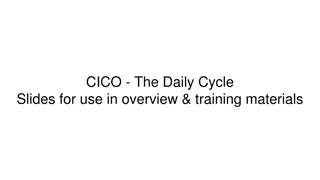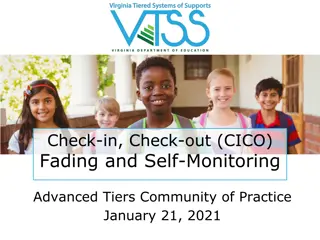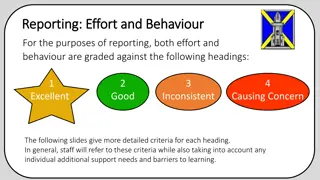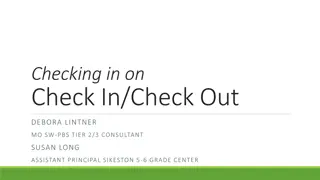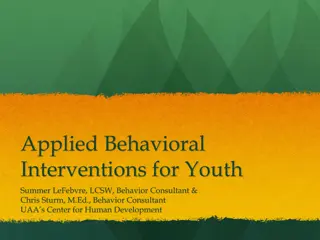Behavior Education Program (BEP) / Check-In Check-Out (CICO) Overview
The Behavior Education Program (BEP) and Check-In Check-Out (CICO) are structured interventions aimed at improving behavior in students through goal-setting, feedback, and reinforcement. This program involves daily check-ins and check-outs with staff members, regular feedback from teachers, and the use of performance data to track progress. Implemented with the support of research, BEP/CICO offers benefits like improved behavior and academic performance, but also comes with challenges. The process includes student goal setting, daily monitoring, family involvement, and regular evaluations to assess progress.
Download Presentation

Please find below an Image/Link to download the presentation.
The content on the website is provided AS IS for your information and personal use only. It may not be sold, licensed, or shared on other websites without obtaining consent from the author.If you encounter any issues during the download, it is possible that the publisher has removed the file from their server.
You are allowed to download the files provided on this website for personal or commercial use, subject to the condition that they are used lawfully. All files are the property of their respective owners.
The content on the website is provided AS IS for your information and personal use only. It may not be sold, licensed, or shared on other websites without obtaining consent from the author.
E N D
Presentation Transcript
A Look at: The Behavior Education Program (BEP)/ Check-In Check-Out (CICO) Materials used with permission and adapted from presentation by Leanne Hawken (2015)
Agenda A look at BEP/CICO What is BEP/CICO? What does the supporting research for BEP/CICO say? What are the benefits and challenges? How do I implement BEP/CICO in my school? BEP Coordinator Daily Progress Report Daily Data for Decision Making
What is The Behavior Education Program (BEP)/ Check-In Check-Out (CICO) The Check In Check Out program is sometimes referred to as the Behavior Education Program (BEP). Students are presented with daily/weekly goals and then receive frequent feedback on meeting the goals throughout the day. The feedback system is connected to the schoolwide behavior expectations. Basic features of the Check-in/Check-out program include: Check-in and check-out daily with an adult at school Regular feedback and reinforcement from teachers Family component Daily performance data used to evaluate progress https://miblsi.org/training-materials/miblsi/elementary-and-secondary-tier-2-behavior-intervention- check-incheck-out-%28cico%29
Student Recommended for BEP/CICO BEP-CICO Implementation Process BEP/CICO Implemented BEP Coordinator Summarizes Data For Decision Making Morning Check-in/DPR Pick-up Parent Feedback Regular Teacher Feedback Bi-weekly BEP Meeting to Assess Student Progress Afternoon Check-out Revise Program Exit Program Leanne S. Hawken, PhD - 2010
Procedure of BEP/ CICO Immediately after the morning announcements the student goes either to their designated staff member or if needed the staff member goes directly to the student. The interaction is to be brief to remind the student of the school expectations and to begin the students day POSITIVELY. Different staff members are responsible for filling out the students points during the identified times. For example if a student has a special the music, art , interventionist, or gym teacher will need to fill out the points in the specials box. In addition, recess and lunch staff will need to fill out the card during those times. At the end of the day, the student returns to their designated staff member to check-out. At this time the staff member reviews their point sheet and collects it from the student. Leanne S. Hawken, PhD - 2010
Example: Morning Example from Green Meadow Elementary Check-in 8:35 - 8:50 Holly gets off the bus, has breakfast, goes to class and then to Check & Connect in Mrs. Coleman s office. (off the library) If anyone else is with Mrs. Coleman, Holly knows to take a seat at the table just outside of Mrs. C. s office. Everyone is met with alone. Holly s turn! She receives a copy of her checksheet for the day. Every goal is gone over every morning. A reminder that the goal for the day is 80% or better. Daily Questions: Are these reasonable? Are they doable? Can you do it? Questions that vary depending on student: Did you have breakfast? Did you get enough sleep? Did you take your medicine? Are you ready for the day or do you still need a little time? Okay ! Off you go with High 5s , smiles, jokes, hugs, and a I can do it attitude!! http://miblsi.cenmi.org/MiBLSiModel/Implementation/ElementarySchools/TierIISupports/Behavi or/TargetBehaviorInterventions/CheckInCheckOut.aspx
Example: Evening Example from Green Meadow Elementary Check-Out 3:30 - 3:35 Holly leaves class and reports to Mrs. Coleman s office. Again, she waits her turn so that she can have one-on-one time. When it s her turn, her daily points are totaled - Mrs. Coleman guides her to calculate her own percentage for the day. Once the percentage is determined, Mrs. Coleman and Holly discuss and celebrate her successes. If her score is 80% or better, Holly gets a Ci3T ticket If Holly has 80% or better, daily, for a week (5 Ci3T tickets), Holly chooses from her reward list. Mrs. Coleman sends her on her way with a positive feeling about her day and her accomplishments. http://miblsi.cenmi.org/MiBLSiModel/Implementation/ElementarySchools/TierIIS upports/Behavior/TargetBehaviorInterventions/CheckInCheckOut.aspx
Manual on How to Implement BEP/CICO Crone, Hawken, & Horner (2010). Responding to Problem Behavior in Schools: The Behavior Education Program (2nd ed). New York, NY: Guilford Press Leanne S. Hawken, PhD - 2010 8
DVD on how to Implement BEP/CICO Hawken, Pettersson, Mootz, & Anderson (2005). The Behavior Education Program: A Check-in, Check- out Intervention for Students at Risk. New York, NY: Guilford Press. Leanne S. Hawken, PhD - 2010 9
Supporting Research on BEP/CICO Effective in reducing problem behavior for: Elementary school students (Cheney et al., 2009; Fairbanks, Sugai, Guardino, & Lathrop, 2007; Filter et al., 2007; Hawken, MacLeod, & Rawlings, 2007; McCurdy, 2007; Stage, Cheney, Flower, Templeton, & Waugh, 2010; Todd, Kaufman, Meyer, & Horner, 2007). Middle School Students (Hawken, 2006; Hawken & Horner, 2003; March & Horner, 2002) Students in Urban School Settings (McCurdy, 2007) Students with disabilities (Hawken, et al., 2007, MacLeod, Hawken, & O Neill, 2010) ***Problem behaviors measured via direct observation, rating scales, changes in percentage of points earned on DPRs, & reductions in ODRs Leanne S. Hawken, PhD - 2010
Supporting Research on BEP/CICO Effective in increasing academic engagement, including for students in high school settings (Hawken & Horner, 2003, Swain-Bradway, 2009) Reduced need for Tier 3 and special education supports following CICO implementation (Hawken, et al., 2007) Overall range of effectiveness of CICO ranges from 40% to 70% (Fairbanks, et al., 2007) (Hawken, et al., 2007) Leanne S. Hawken, PhD - 2010
Supporting Research on BEP/CICO More effective with students with attention- maintained problem behavior (March & Horner, 2002; McIntosh, et., al., 2009, Campbell & Anderson, 2008) Effective across behavioral functions (Hawken, O Neill, & MacLeod, 2011) Students who do not respond to CICO benefit from function-based, individualized interventions (Fairbanks, et., al., 2007, March & Horner, 2002; Macleod, Hawken, & O Neill, 2010) Leanne S. Hawken, PhD - 2010
Supporting Research See BEP Resource Guide for additional supporting research and information.
Benefits and Challenges Benefits Can be implemented across the grade-span Increased academic engagement Can be effective across behavior functions Builds rapport for students Up to 15-20 students (depending on school size/ resources) can be served per coordinator Challenges Can be time intensive Often requires training for coordinator Most effective with attention- maintained problem behavior, not as effective with task- avoidance or attention- avoidance problem behaviors Some students are going to need more intensive support than the BEP can provide.
How do I implement BEP/CICO in my classroom? Step 1 Establish prerequisite conditions Identify students who might benefit using entry criteria from intervention grid Step 2 Identify a team member with rapport or CICO coordinator to check in daily with student Step 3 Create or modify CICO sheet to match student behaviors and reinforcement preferences Step 4
How do I implement BEP/CICO in my classroom? Step 5 Train student on CICO procedures Step 6 Morning Check in with CICO coordinator Step 7 Regular Teacher check in during day Step 8 Afternoon check out with student Daily report sent home to parent for positive feedback Step 9
BEP Readiness Checklist (Crone, Hawken, & Horner, 2010) School-wide system (Tier 1) of behavior support in place Staff buy-in for implementation of the BEP Administrative support Time & money allocated No major changes in school climate e.g. teacher strikes, administrative turnover, major changes in funding BEP implementation a top priority Leanne S. Hawken, PhD - 2015 17
BEP Implementation Considerations BEP overview to team Considerations for BEP implementation: Selecting a BEP Coordinator? Location for check-in and check-out procedures Maximum number of students that school can feasibly server with BEP Name of BEP for your school and (consider names for daily progress report card) Procedures for when coordinator is absent Crone, D., Horner, Robert H, & Hawken, Leanne S. (2010). Responding to problem behavior in schools: The behavior education program. New York, NY: Guilford Press. 18
BEP Coordinator Lead morning check-in/ afternoon check- out Enter BEP data on spreadsheet daily Organize and maintain records Create graphs for BEP meetings Gather supplemental information for BEP meetings Prioritize BEP students for team meetings Leanne S. Hawken, PhD - 2015 19
Characteristics of an effective BEP coordinator Flexibility within job responsibility (e.g., Educational Assistant/Paraprofessional.) Positive and enthusiastic Someone the students enjoy and trust Organized and dependable Works at school every day Leanne S. Hawken, PhD - 2015 20
Whats in a Name? Behavior Education Program (BEP) Daily Progress Report Kennedy Card Program Kennedy Card Hello, Update, & Goodbye (HUG program) Hug Card HAWK Program (Helping A Winning Kid) Hawk Report ROAR Program (Reinforcement of Appropriate Responses) Wild Card *Caution with Using Behavior Card or Behavior Plan Leanne S. Hawken, PhD - 2015 21
Daily Progress Report Goals 1/5 2/6 3/7 HR 4/8 Be respectful 2 1 0 2 1 0 2 1 0 2 1 0 2 1 0 Be responsible 2 1 0 2 1 0 2 1 0 2 1 0 2 1 0 2 1 0 2 1 0 2 1 0 2 1 0 2 1 0 Keep Hand & Feet to Self Follow Directions 2 1 0 2 1 0 2 1 0 2 1 0 2 1 0 2 1 0 2 1 0 2 1 0 2 1 0 2 1 0 Be There Be Ready TOTAL POINTS Leanne S. Hawken, PhD - 2015 22
KENNEDY CARD Name _____________________________________________________ Material s To Class Worked and Let Others Work Follow Directions the First Time Teacher Parent 2 1 2 1 2 1 Assignments: Wow, No No No 2 1 2 1 2 1 Assignments: Wow, No No No 2 1 2 1 2 1 Assignments: Wow, No No No 2 1 2 1 2 1 Assignments: Wow, No No No 2 1 2 1 2 1 Assignments: Wow, No No No 2 1 2 1 2 1 Assignments: Wow, No No No = _____ Goal = 36 Leanne S. Hawken, PhD - 2015 23
BEP Daily Progress Report Template- Elementary See DAILY PROGRESS REPORT TEMPLATE ELEMENTARY VERSION on Ci3T.org
BEP Daily Progress Report Template See DAILY PROGRESS REPORT TEMPLATE on Ci3T.org
Check Check- -in, Check in, Check- -out Form: Elementary School Version out Form: Elementary School Version Check % of points earned Check- -Out % of points earned Out Goal Goal Check- -in Check in Delivered Contract Delivered Contract Signed Parent Copy of DPR Signed Parent Copy of DPR Student Student Jason 90 85 Leanne 85 85 Juan 60 75 Kiran 100 85 Alexa 95 85 Jacey 0 75 Leanne S. Hawken, PhD - 2015 26
BEP Home Report Template See BEP HOME REPORT TEMPLATE on Ci3T.org 27
Will you please . 1. How will the BEP be implemented in your school? (consider logistics such as identifying a BEP coordinator, location, entry criteria, etc.) 2. Develop a Daily Progress Report (DPR) Activity: Consider consulting the BEP Development and Implementation Guide Crone, D., Horner, Robert H, & Hawken, Leanne S. (2010). Responding to problem behavior in schools: The behavior education program. New York, NY: Guilford Press. Let s talk
Sample Elementary Intervention Grid Support Description School-wide Data: Entry Criteria Behavior: SRSS-E7 score: Moderate (4-8) SRSS-I5 score: Moderate (2-3) or SRSS-E7 score: High (9-21) SRSS-I5 score: High (4-15) or 2 or more office discipline referrals (ODR) in a 5 week period Or 2 or more tardies or absences per quarter Data to Monitor Progress Student measures: Daily progress reports Exit Criteria Participating students check in and out with a mentor each day on targeted goals. During check- in, students receive a daily progress report that they take to each class for feedback on their progress meeting the school-wide Ci3T model expectations. SRSS-E7 score: Low (0-3) SRSS-I5 score: Low (0-2) BEP (Check In, Check- Out) Treatment integrity: Coach completes checklist of all BEP steps and whether they were completed each day (percentage of completion computed) With 8 weeks of data, student has made their CICO goal 90% of the time and there have not been any office discipline referrals. The teacher is then contacted for their opinion about if exiting is appropriate or if CICO should continue. Social Validity: Teacher: IRP-15 Student: CIRP AND/OR Academic: Progress report: 1 or more course failures Progress report: Targeted for Growth for academic learning behaviors See BEP Intervention Grid
Sample Middle and High School Intervention Grid Support Description School-wide Data: Entry Criteria Behavior: SRSS-E7 score: Moderate (4-8) SRSS-I6 score: Moderate (4-5) or SRSS-E7 score: High (9-21) SRSS-I6 score: High (6-18) or 2 or more office discipline referrals (ODR) in a 5 week period Or 2 or more tardies or absences per quarter Data to Monitor Progress Student measures: Daily progress reports Exit Criteria Participating students check in and out with a mentor each day on targeted goals. During check- in, students receive a daily progress report that they take to each class for feedback on their progress meeting the school-wide Ci3T model expectations. SRSS-E7 score: Low (0-3) SRSS-I5 score: Low (0-3) BEP (Check In, Check- Out) Treatment integrity: Coach completes checklist of all BEP steps and whether they were completed each day (percentage of completion computed) With 8 weeks of data, student has made their CICO goal 90% of the time and there have not been any office discipline referrals. The teacher is then contacted for their opinion about if exiting is appropriate or if CICO should continue. Social Validity: Teacher: IRP-15 Student: CIRP AND/OR Academic: Progress report: 1 or more course failures Progress report: Targeted for Growth for academic learning behaviors See BEP Intervention Grid
Will you please . Discuss Reinforcement logistics Referral process (Use your Ci3T Secondary [Tier 2] Intervention grid) Activity: Consider consulting the BEP Development and Implementation Guide #3 & 4 Crone, D., Horner, Robert H, & Hawken, Leanne S. (2010). Responding to problem behavior in schools: The behavior education program. New York, NY: Guilford Press. Let s talk
Tracking Student BEP Progress (number = % of total daily points) Date Jason Leanne Juan Kiran Alexa 1/16 85 95 100 80 65 1/17 100 100 100 75 77 1/18 77 0 100 85 63 1/19 45 75 95 92 85 1/20 88 89 77 89 90 1/23 79 0 100 95 95 1/24 95 67 85 100 78 Leanne S. Hawken, PhD - 2015 32
Daily Data Used for Decision Making Decision-Making: Plan is working as intended Ryan's BEP Performance 2000-2001 100 Percentage of Points 80 60 40 20 0 03/07 03/08 03/09 03/12 03/13 03/14 Date Leanne S. Hawken, PhD - 2015 33
Daily Data Used for Decision Making Rachelle's BEP Performance 2000-2001 Decision-Making: Alternative reinforcer? 100 Percentage of Points 80 60 40 20 02/05 02/08 02/13 02/20 02/23 Date Leanne S. Hawken, PhD - 2015 34
Collecting Baseline Data Give teacher a packet of 5 baseline DPR forms (colored paper- Not on NCR) Have teacher rate student on the DPR but NOT GIVE STUDENT FEEDBACK During baseline student does not check- in or check-out Parental consent is being obtained during baseline Leanne S. Hawken, PhD - 2015 35
Goal line To test the effectiveness of Check-in/Check-out for a student, you could use a withdrawal design. Leanne S. Hawken, PhD - 2015 36
Data Collecting See BEP Student DPR Data Tracker on Ci3T.org
BEP Development & Implementation Guide (Cont. Hawken, 2004) Considerations for fading students off of the intervention Criteria for fading students intervention? Exit Criteria in your Secondary (Tier 2) BEP Intervention Grid Procedures for fading and personal in charge of helping students fade off of the BEP? Self-Management Graduation celebration and continuing supports (e.g., alumni parties, weekly check-in) Crone, D., Horner, Robert H, & Hawken, Leanne S. (2010). Responding to problem behavior in schools: The behavior education program. New York: Guilford Press 38
Fading and Self-Monitoring: Phase 1 Phase 1 Teacher and student are given copy of self- monitoring form to complete daily At end of each marking period, student and teacher compare forms and look for matches Teacher and student agree upon percentage of points earned for the day Extra points are rewarded for teacher and student matches Leanne S. Hawken, PhD - 2015 39
Fading and Self-Monitoring: Phase 2 Phase 2 Student checks in at beginning of week and check s out at end of week Student completes self-monitoring booklet and receives teacher feedback at end of week Student is rewarded at the end of each week for meeting goal Leanne S. Hawken, PhD - 2015 40
Sample Elementary Intervention Grid Support Description School-wide Data: Entry Criteria Behavior: SRSS-E7 score: Moderate (4-8) SRSS-I5 score: Moderate (2-3) or SRSS-E7 score: High (9-21) SRSS-I5 score: High (4-15) or 2 or more office discipline referrals (ODR) in a 5 week period Or 2 or more tardies or absences per quarter Data to Monitor Progress Student measures: Daily progress reports Exit Criteria Participating students check in and out with a mentor each day on targeted goals. During check- in, students receive a daily progress report that they take to each class for feedback on their progress meeting the school-wide Ci3T model expectations. SRSS-E7 score: Low (0-3) SRSS-I5 score: Low (0-2) BEP (Check In, Check- Out) Treatment integrity: Coach completes checklist of all BEP steps and whether they were completed each day (percentage of completion computed) With 8 weeks of data, student has made their CICO goal 90% of the time and there have not been any office discipline referrals. The teacher is then contacted for their opinion about if exiting is appropriate or if CICO should continue. Social Validity: Teacher: IRP-15 Student: CIRP AND/OR Academic: Progress report: 1 or more course failures Progress report: Targeted for Growth for academic learning behaviors See BEP Intervention Grid
Sample Middle and High School Intervention Grid Support Description School-wide Data: Entry Criteria Behavior: SRSS-E7 score: Moderate (4-8) SRSS-I6 score: Moderate (4-5) or SRSS-E7 score: High (9-21) SRSS-I6 score: High (6-18) or 2 or more office discipline referrals (ODR) in a 5 week period Or 2 or more tardies or absences per quarter Data to Monitor Progress Student measures: Daily progress reports Exit Criteria Participating students check in and out with a mentor each day on targeted goals. During check- in, students receive a daily progress report that they take to each class for feedback on their progress meeting the school-wide Ci3T model expectations. SRSS-E7 score: Low (0-3) SRSS-I5 score: Low (0-3) BEP (Check In, Check- Out) Treatment integrity: Coach completes checklist of all BEP steps and whether they were completed each day (percentage of completion computed) With 8 weeks of data, student has made their CICO goal 90% of the time and there have not been any office discipline referrals. The teacher is then contacted for their opinion about if exiting is appropriate or if CICO should continue. Social Validity: Teacher: IRP-15 Student: CIRP AND/OR Academic: Progress report: 1 or more course failures Progress report: Targeted for Growth for academic learning behaviors See BEP Intervention Grid
BEP Development & Implementation Guide (Hawken, 2004) Develop Student and Parent Training Who will train students on how to participate in the intervention? How will parents be trained on how to provide feedback at home? Training Who will train staff on the BEP? Who will provide feedback to teachers implementing BEPs to ensure fidelity? Who can provide annual booster sessions about the purpose and key features in implementing the program? 43
Will you please . Discuss System for managing daily data Plan for fading Staff, Student and Parent Trainings Activity: Consider consulting the BEP Development and Implementation Guide #5, 6, 7, & 8 Crone, D., Horner, Robert H, & Hawken, Leanne S. (2010). Responding to problem behavior in schools: The behavior education program. New York, NY: Guilford Press. Let s talk
How well is it working? Examining the Effects Experimental Design Treatment Integrity Social Validity Is it What do stakeholders think about the goals, procedures, How well did this support work for happening? this and student? outcomes?
Treatment Integrity Have structures in place to monitor whether BEP/CICO is carried out as intended See BEP Treatment Integrity Checklist on Ci3T.org
What do they think about it? Intervention Rating Profile (IRP-15) Completed by the teacher and/or parent participating in the intervention at two time points: Pre and post intervention See Social Validity Adapted IRP15_Pre/ Post_ Teacher
What do they think about it? Children s Intervention Rating Profile (CIRP) Completed by the student participating in the intervention at two time points: Pre and Post Intervention See Social Validity Adapted CIRP_Pre/Post_Student Pre and Post Versions
Hawken, L. S., Pettersson, H., Mootz, J., & Anderson, C. (2006) The behavior education program: A check-in, check-out intervention for students at risk. New York, NY: Guilford Press. http://www.guilford.com/videos/The-Behavior- Education-Program/Hawken-Pettersson-Mootz- Anderson/9781593854164/summary Crone, D., Horner, Robert H, & Hawken, Leanne S. (2010). Responding to problem behavior in schools: The behavior education program. New York, NY: Guilford Press.






